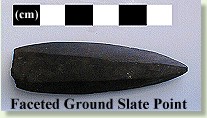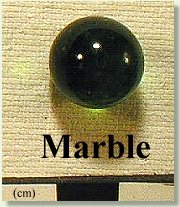
|
Kosapsom's Three Time Periods:
|
Before Present |
Gregorian Calendar |
| Locarno Beach |
3500y - 2500y |
1500 BC - 500 BC |
| Gulf of Georgia |
1650y - 160y |
AD 400 - 1790 |
| Historic |
160y - present |
AD 1790 - present |
Locarno Beach Culture Type

|

|
Microblade
Made from
Volcanic Glass
|
Most of the artifacts recovered from DcRu4 are from the Locarno Beach Culture Type, roughly (3500y - 2500y BP). Artifacts such as microblades (volcanic glass and quartz crystal), faceted ground slate points, basalt flake detritus and small rectangular well-finished ground stone adzes are common at Locarno Beach.
Glossary terms: Culture Type, Faceted, Basalt, Detritus,
Adze.

|
Faceted Ground Slate Point
Most Distinctive
of Locarno Beach
|
Browse through the on-line database for more pictures of Locarno Beach artifacts. Most Locarno Beach sites are shell middens. Food sources were usually obtained from the sea, such as salmon, herring, shellfish, sea lions and porpoise.
Unfortunately at Kosapsom, there is a slight overlap of Locarno Beach culture type and Gulf of Georgia culture type because of landscaping. Locarno Beach artifact assemblage got mixed in with Gulf of Georgia components and historic materials because it is where the schoolyard garden used to be.
Glossary terms: Assemblage, Component.
Gulf of Georgia Culture Type

|

|
Unilaterally-barbed Bone Point
Used in Hunting
|
This period is characterized with more ground bone tools than stone tools. Microblades are generally absent as are large stone bifaces. There are more unilaterally-barbed bone points, bone bipoints, bone unipoints, bone awls, and antler wedges. Wood was generally used with increasing frequency during this period, but none has been recovered yet.
Glossary terms: Biface, Bipoint, Unipoint, Awl, Wedge.
Historic Culture Type

|
Bone Button
Carved piece
|
This is referred to as the Craigflower Schoolhouse and Farm era. This period contains remnants of slate pencils, slate boards (writing material of schoolchildren), pins, buttons, nails, glass and marbles.

|

|
Historic Marble
Found in upper levels
|
There has been some preliminary analysis on the evolution of nails found here: the earliest were the hand-forged spikes and nails, then followed the cut nails and eventually common wire nails, roofing nails and thumb tacks. When the school closed in 1910, the site was used as an informal park and excavations uncovered artifacts ranging from coins, bottle caps, wire, lead shot, bullets and cartridges.
Glossary terms: Cut Nail, Wire Nail, Roofing Nail, Cartridge.
|



